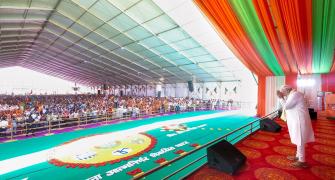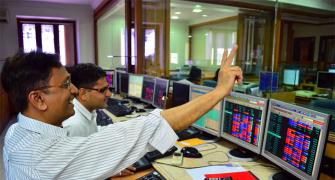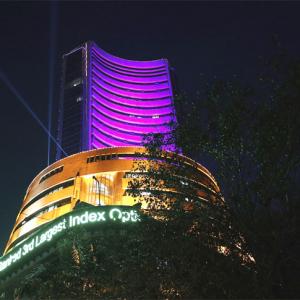Some oil industry experts believe crude oil prices should remain range-bound with some softness -- but if West Asia is further destabilised, then oil prices may react unpredictably. India’s equity indices are up almost 25 per cent in 2014 so far, including the nearly 10 per cent gain since Narendra Modi took charge as prime minister in May this year.
India’s equity indices are up almost 25 per cent in 2014 so far, including the nearly 10 per cent gain since Narendra Modi took charge as prime minister in May this year.
This is remarkable especially since it comes on top of a nine per cent rise in 2013 and a much higher 25.7 per cent rise in 2012.
The problem is that fundamentals are yet to catch up.
This rally is largely being driven by hopes that the Modi government will drive economic growth higher, and, thus, increase earnings growth for companies.
Thus, questions about the sustainability of this market are valid -- given geopolitical risks, as well as the uncertainty over liquidity withdrawal and possible rate tightening by the United States Federal Reserve in 2015.
At the moment, the price of Brent crude oil has fallen to around $100 a barrel, helping the import bill, trade deficit, oil subsidies and inflation.
Some oil industry experts believe crude oil prices should remain range-bound with some softness -- but if West Asia is further destabilised, then oil prices may react unpredictably.
The monsoons may still be sub-par, but vegetable prices seem firm, and it is unclear what the effect will be on demand.
On some occasions, India has managed reasonably well during sub-par monsoons.
Meanwhile, the Reserve Bank of India will consider its inflation-fighting to be showing results, and, thus, will likely stay the course.
Real interest rates are positive now that consumer price inflation is around eight per cent -- down from over 10 per cent in 2013 --
This might encourage people to move away from real estate and gold. Higher saving might also help investment, and provide an impetus to the private sector.
Certainly, the confidence level in India Inc is higher than it was last year.
Higher earnings from 2015-16 onwards are firmly expected.
In 2014-15, the rise in earnings per share for the Sensex stocks was eight per cent; but expectations are that EPS will grow by 20 per cent in 2015-16 and by 16 per cent in 2016-17.
These expectations have fuelled hopes for the broader market: in the past decade, it has been seen that market returns are usually weak to negative when Sensex earnings growth tapers to single digits, and price-to-earnings multiples fall below the long-term average.
Right now, the Sensex’s PE is about 18.3, only marginally lower than the average since 2003, 18.4.
If the market is right about projected earnings -- which is never certain -- then stocks are not really that expensive by historical standards.
Barring the high valuations of 2007 and low valuations of 2008, the Sensex’s PE has been between 15 and 25 since 2003.
Interest rates may have peaked; inflation will hopefully inch lower; and, if earnings growth also picks up, then the market is in a comfortable position.
However, this optimistic assessment depends crucially on hopeful earning projections.
Many risks remain, external as well as internal -- especially the high expectations from the government.
If earnings do not perform as expected, and confidence in the new government collapses, a sharp correction might be on the cards.










